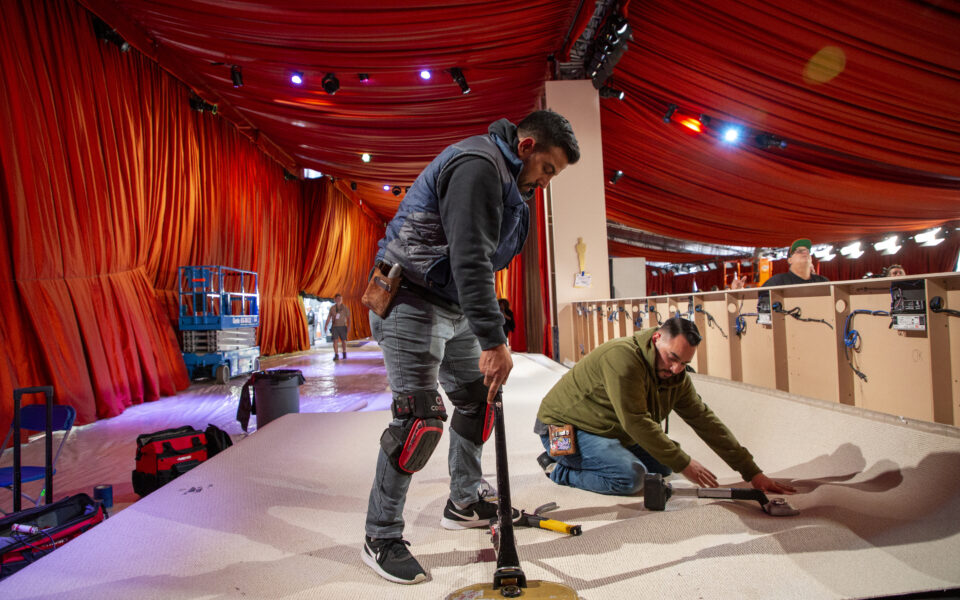Hey, that red carpet isn’t red!

There are some fundamental truths in the world: The sky is blue. The grass is green. The Oscars red carpet is re –– champagne-colored.
Jimmy Kimmel, this year’s host, joked at the unveiling Thursday that the color change – the first time in more than six decades that the academy’s arrival rug will not be red – had been prompted by Will Smith slapping the comedian Chris Rock across the face onstage at last year’s ceremony.
“I think the decision to go with a champagne carpet rather than a red carpet shows just how confident we are that no blood will be shed,” he said.
Oscars organizers said they wanted the rug to be mellow, like a beach at sunset.
The 50,000-square-foot rug, which was created in a color chosen by the academy, is the latest in a trend of colorful carpets sweeping premieres, galas and award ceremonies across the country, from the Emmys (gold) to the Golden Globes (gray) to the purple-carpeted world premiere of “Black Panther: Wakanda Forever” in Los Angeles in November.
“Every year, a new color will be a hot color,” said Steve Olive, president of Event Carpet Pros, the company that has manufactured the carpet for the Oscars for more than 20 years, as well as events on both coasts including the Golden Globes, the Emmy Awards, the Grammy Awards and thousands of movie premieres. “This year seems to be a lot of lavender,” he said. (Red, he notes, is still the most popular color, though black, white and gray are gaining on it.)
For the Oscars production team, which chose the champagne color, the priority was a light, “soothing” color that would not clash with the orange tent that will be erected over the carpet to shield attendees from the sun and potential rain.
(They also considered chocolate brown, said Lisa Love, who was a red carpet creative consultant for the Oscars for the first time this year and is also a creative contributor for the Met Gala, which has been known for its eye-catching floor wear.)
“The sienna-color tent and champagne-colored carpet was inspired by watching the sunset on a white-sand beach at the ‘golden hour’ with a glass of champagne in hand, evoking calm and peacefulness,” she said in an interview Thursday.
The red carpet traces its origins back to 458 BC, when it appeared in the Aeschylus play “Agamemnon.” When the Greek king Agamemnon returns home victorious from the Trojan War, his vengeful wife, Clytemnestra, tries to trick him into arrogance by laying out a red carpet for him to walk on, an action that, undertaken by a mere mortal, would court the wrath of the gods. (He takes the bait and, shortly afterward, she murders him in a bathtub.)
Red carpets have been a staple at premieres and galas since 1922, when the showman Sid Grauman rolled one out for the 1922 premiere of “Robin Hood,” which starred Douglas Fairbanks, at the Egyptian Theater in Hollywood. The Oscars adopted it beginning with the 1961 ceremony, and, ever since, the special shade – known as Academy Red – has been instantly recognizable in photos.
But beginning about 15 years ago, at events across the country, producers began opting for more vibrant and varied fare, Olive said. There are the Met Gala’s pink and red, white and blue carpets, and Disney’s blue (“Moana” and “Avatar: The Way of Water”), white with black thorns (“Maleficent: Mistress of Evil”) and green (“Pete’s Dragon”) carpets for its premieres.
“It’s important for us as creatives and producers to create visuals that stand out from each other,” said Keith Baptista, a partner at the creative agency Prodject, which handles design and management for events such as the LACMA Art + Film Gala and the MoMA Film Benefit, and works with companies including Chanel, Gucci and Ralph Lauren. “You want to be able to look at something at a quick glance and go, ‘That was the Met Gala’ or ‘That was Vanity Fair.’”
Mindi Weiss, an event planner who has worked with the Kardashians, Justin Bieber and Ellen DeGeneres, pointed to another consideration: How the carpet will photograph. Red, she said, tradition aside, is simply not flattering.
“The color of red carpets has changed because of fashion,” she said. “It has to match the dresses, and the red clashed.”
In fact, event planners say trends in carpet colors now correlate with trends on the runways.
“It all goes back to fashion and style and trendsetting,” Weiss said. “The carpet should reflect the fashion that’s going to walk down it and not fight with it.”
But a striking color does not always complement what celebrities are wearing, Baptista said – or photograph well. The wrong tone of gold, for instance, can wash out a photo, said Stephanie Goodell, who has led what the Television Academy refers to as its “SWATCH” team for the Emmys for the past seven years. To head off any issues, production companies do extensive lighting, color and even footprint testing beforehand, and warn stylists.
“We’re in constant communication with publicists before the show,” Goodell said. “We always want to make sure they know exactly what we’re dealing with because they do select fashion based on the color of the carpet.”
Planning teams for big-ticket events generally begin considering the carpet – the color, material, length, width and pile type – six months to a year before the event. They also look for other ways to stand out, such as inscribing a logo or lettering on the carpet, Baptista said.
“Sometimes we’ll see people use grass, especially for summertime events,” he said. Then, for the background, “a lot of people use hedgerows, so it’s just greenery and it becomes neutral. Sometimes, there’s no logo,” he said.
For the Oscars, Olive got the call that carpet would be champagne about 45 days before the show. He rushed to get the three-week manufacturing process underway, which takes place at a mill in Dalton, Georgia, before the carpet is trucked across the country to Los Angeles, which takes about a week.
So what happens to the carpet after Cate Blanchett and Austin Butler have strolled it?
Its future, Olive said, does not lie in an industrial-size dumpster. The polyester-based, sisal-style rug is made from recycled materials and is recycled after the event, possibly beginning life anew as wall insulation or carpet padding, Olive said.
But first, it has to look sharp on the big night. So, was this year’s Oscars squad worried that the champagne carpet – the kind of flooring that screams “Shoes-off house!” – would get dirty?
“It will probably get dirty – maybe it wasn’t the best choice,” Love said. “We’ll see!”
This article originally appeared in The New York Times.






